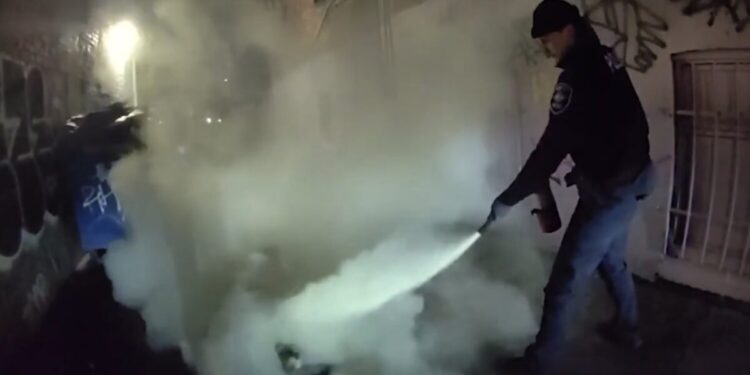A man remains in critical condition after apparently setting himself on fire early Monday morning in Seattle’s University District.
Officers were called around 3:10 a.m. to Brooklyn Avenue Northeast and Northeast 45th Street after receiving reports of a man on fire. They arrived within five minutes and spotted a man engulfed in flames running through a nearby alleyway.
The man is seen on police dashcam running through the alley while officers yell at him to “stop, drop and roll” to put out the flames.
Officers eventually exited their patrol car and chased the man down, using a fire extinguisher on him as he collapsed.
The Seattle Fire Department arrived shortly after and provided medical treatment to the man, then transported him to Harborview Medical Center. He suffered second-degree burns over much of his body.
According to authorities, surveillance video from a nearby building revealed the man had fallen asleep next to a makeshift fire, which spread to his clothes and engulfed his body in flames.
The man is currently in critical condition at Harborview Medical Center.
The 3:10 a.m. timing places the incident during the overnight hours when University District streets are largely empty except for late-night workers, insomniacs, and homeless individuals seeking shelter or warmth in doorways and alleyways.
The five-minute police response time demonstrates Seattle Police Department’s ability to rapidly deploy officers in the University District, a neighborhood with concentrated patrol presence due to proximity to the University of Washington campus and its associated public safety concerns.
The man running through an alleyway while engulfed in flames suggests panic and disorientation from pain and shock, with survival instincts compelling him to flee rather than follow the “stop, drop and roll” instructions officers shouted from their vehicle.
The dashcam footage capturing the burning man running provides dramatic documentation of the incident while raising questions about whether body-worn camera video also recorded officers’ heroic actions extinguishing flames and saving a life.
The officers’ decision to chase the man down and deploy fire extinguishers represents split-second judgment prioritizing immediate life-saving intervention over waiting for Seattle Fire Department’s arrival with specialized medical equipment and burn treatment capabilities.
The collapse as officers applied fire extinguisher chemicals indicates either the man’s body succumbing to shock and pain or the fire extinguisher’s chemical suppressant overwhelming his respiratory system, though the intervention ultimately prevented further burning.
The second-degree burns over much of his body signify partial-thickness skin damage extending through the epidermis into the dermis, requiring extensive medical treatment including debridement, skin grafts, and prolonged hospitalization with infection prevention protocols.
The makeshift fire scenario revealed by surveillance video suggests the man was experiencing homelessness or housing instability, using fire for warmth during the cool October night when temperatures likely dropped into the 40s.
The falling asleep next to the fire demonstrates the desperate choices homeless individuals make seeking warmth, with exhaustion overcoming caution as the man lost consciousness near open flames that subsequently ignited his clothing.
The fire spread to clothes and body engulfment indicates the man wore synthetic fabrics that melt and adhere to skin rather than natural fibers that burn away, compounding injury severity and complicating medical treatment.
The Brooklyn Avenue Northeast and Northeast 45th Street location places the incident in the heart of the University District’s commercial core, an area with restaurants, shops, and apartment buildings where alleyways provide secluded spaces attracting homeless encampments.
The surveillance video from a nearby building providing crucial evidence of fire origin demonstrates the proliferation of security cameras throughout urban areas that assist investigations while raising privacy concerns about constant monitoring of public spaces.
The critical condition designation at Harborview Medical Center indicates the man faces life-threatening complications from his burns, potentially including respiratory damage from smoke inhalation, infection risks from compromised skin barriers, or organ failure from shock.
Harborview Medical Center’s role treating the victim reflects the hospital’s status as the Pacific Northwest’s only Level I adult and pediatric trauma center with specialized burn unit treating the most severe cases throughout the region.
The officers’ fire extinguisher deployment likely involved dry chemical or CO2 extinguishers standard in patrol vehicles, designed for vehicle fires but adaptable for burning clothing though potentially causing respiratory distress when sprayed on a person’s face.
The University District’s concentration of homeless individuals seeking warmth and shelter creates recurring scenarios where makeshift fires endanger lives, with this incident representing extreme outcome of survival strategies that frequently result in property damage and minor injuries.
The incident highlights Seattle’s ongoing homelessness crisis where individuals without shelter resort to dangerous warming methods, creating public safety incidents requiring emergency response resources and expensive medical interventions that exceed the cost of providing adequate housing.
The police officers’ heroic actions preventing the man from burning to death deserve recognition while raising questions about whether adequate social services and shelter capacity could have prevented the situation requiring such dramatic intervention.
The makeshift fire’s location in an alleyway suggests the man chose a secluded spot trying to avoid detection by police or property owners who might force him to move, ironically leading to isolation that nearly cost his life.







